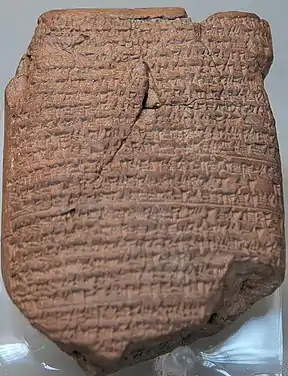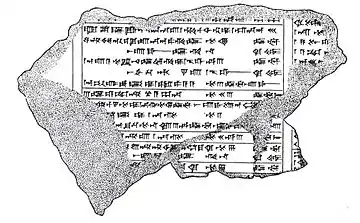Babylonian Chronicles
The Babylonian Chronicles are a loosely-defined series of about 45 tablets recording major events in Babylonian history.[2]
They represent one of the first steps in the development of ancient historiography. The Babylonian Chronicles are written in Babylonian cuneiform and date from the reign of Nabonassar until the Parthian Period. The tablets were composed by Babylonian astronomers ("Chaldaeans") who probably used the Astronomical Diaries as their source.
Almost all of the tablets were identified as chronicles once in the collection of the British Museum, having been acquired via antiquities dealers from unknown excavations undertaken during the 19th century. All but three of the chronicles are unprovenanced.[2]
The Chronicles provide the "master narrative" for large blocks of current Babylonian history.[2]
Discovery and publication
The chronicles are thought to have been transferred to the British Museum after 19th century excavations in Babylon, and subsequently left undeciphered in the archives for decades. The first chronicle to be published was BM 92502 (ABC1) in 1887 by Theophilus Pinches under the title "The Babylonian Chronicle." This was followed in 1923 by the publication of the Fall of Nineveh Chronicle (ABC 3), in 1924 by Sidney Smith's publication of the Esarhaddon Chronicle (ABC 14), the Akitu Chronicle (ABC 16) and the Nabonidus Chronicle (ABC 7), and in 1956 by Donald Wiseman's publication of four further tablets including the Nebuchadnezzar Chronicle (ABC 5).[3]
Chronicles
Numbering systems
ABC – A.K. Grayson, Assyrian and Babylonian Chronicles (1975)
CM – Jean-Jacques Glassner, Chroniques Mésopotamiennes (1993) (translated as Mesopotamian Chronicles, 2004)
BCHP – I. Finkel & R.J. van der Spek, Babylonian Chronicles of the Hellenistic Period (not yet published)
BM – British Museum Number
List
| Chronicle | ABC | CM | BCHP | BM | Provenanced | |
|---|---|---|---|---|---|---|
| Dynastic chronicle (translation) (another version of Column 5) | 18 | 3 | Yes | |||
| Royal chronicle of Lagaš | 6 | |||||
| Weidner chronicle (translation) | 19 | 38 | Yes | |||
| Early kings chronicle (translation) | 20 | 39,40 | ||||
| Tummal chronicle | 7 | |||||
| Uruk chronicle of the kings of Ur | 48 | |||||
| Assyrian Eponym List (2nd millennium) | 8 | |||||
| Market prices chronicle (translation) | 23 | 50 | ||||
| Synchronic history (translation and another translation) | 21 | 10 | Yes | |||
| Chronicle P (translation and another translation) | 22 | 45 | ||||
| Enlil-nirari chronicle | 11 | |||||
| Arik-den-ili chronicle | 12 | |||||
| Walker chronicle | 25 | 46 | ||||
| Tukulti-Ninurta chronicle | 13 | |||||
| Aššur-reša-iši chronicle | 14 | |||||
| Tiglath-pileser I chronicle | 15 | |||||
| Eclectic chronicle (translation) | 24 | 47 | ||||
| Religious chronicle (translation) | 17 | 51 | ||||
| Assyrian Eponym List (1st millennium) | 9 | |||||
| Nabu-šuma-iškun | 52 | |||||
| From Nabu-Nasir to Šamaš-šuma-ukin (translation) | 1 | 16 | 92502 | |||
| From Nabu-Nasir to Esarhaddon | 1B | 17 | 75976 | |||
| Esarhaddon chronicle (translation) | 14 | 18 | 25091 | |||
| Šamaš-šuma-ukin chronicle (translation) (another translation) | 15 | 19 | 96273 | |||
| Akitu chronicle (translation) | 16 | 20 | 86379 | |||
| Early Years of Nabopolassar chronicle (translation) | 2 | 21 | 25127 | |||
| Fall of Nineveh chronicle (translation) | 3 | 22 | 21901 | |||
| Late years of Nabopolassar chronicle (translation) | 4 | 23 | 22047 | |||
| Early Years of Nebuchadnezzar chronicle (translation) | 5 | 24 | 21946 | |||
| Third year of Neriglissar chronicle (translation) | 6 | 25 | 25124 | |||
| Nabonidus chronicle (text and translation) | 7 | 26 | 35382 | |||
| Chronographic document on Nabonidus | 53 | |||||
| Artaxerxes III chronicle (translation) | 9 | 28 | ||||
| Cyrus cylinder | 17 | 90920 | ||||
| Alexander chronicle (text and translation) | 8 | 29 | 1 | |||
| Alexander and Arabia chronicle (text and translation) | 2 | |||||
| Diadochi chronicle (text and translation) | 10 | 30 | 3 | |||
| Alexander and Artaxerxes (translation) | 4 | |||||
| Antiochus I and Sin temple chronicle (text and translation) | 11 | 32 | 5 | |||
| Ruin of Esagila chronicle (text and translation) | 6 | |||||
| Antiochus, Bactria, and India chronicle (text and translation) | 13A | 36 | 7 | |||
| Juniper garden chronicle (text and translation) | 8 | |||||
| End of Seleucus I chronicle (text and translation) | 12 | 33 | 9 | |||
| Seleucid Accessions chronicle (text and translation) | 13 | 34 | 10 | |||
| Invasion of Ptolemy III chronicle (text and translation) | 11 | |||||
| Seleucus III chronicle (text and translation) | 13B | 35 | 12 | |||
| Politai chronicle (text and translation) | 13 | |||||
| Greek Community chronicle (text and translation) | 14 | |||||
| Gold theft chronicle (text and translation) | 15 | |||||
| Document on land and tithes (text and translation) | 16 | |||||
| Judicial chronicle (text and translation) | 37 | 17 | ||||
| Bagayasha chronicle | 18 | |||||
| Chronicle concerning an Arsacid king (text and translation) | 19 | |||||
| Euphrates chronicle (text and translation) | 20 |
References
- L. W. King (1907). Chronicles Concerning Early Babylonian Kings, Vol. II: Texts and Translations. Luzac and Co. p. 145.
- Waerzeggers, Caroline (2012). "The Babylonian Chronicles: Classification and Provenance". Journal of Near Eastern Studies. University of Chicago Press. 71 (2): 285–298. doi:10.1086/666831. ISSN 0022-2968. S2CID 162396743.
The "Babylonian Chronicles" are a miscellaneous, ill-defined group of texts… The most influential classification is that of A. K.Grayson. His book Assyrian and Babylonian Chronicles (ABC) is the starting point of any study undertaken on the topic. It assembled a variety of chronographic texts, including Assyrian chronicles and other writings which may not belong to the ill-defined chronicle genre (see below)… About forty-five Babylonian chronicles are now known. This includes the twenty-four texts published by Grayson in Assyrian and Babylonian Chronicles and several new additions. The exact number is unclear because the genre is ill-defined… Most chronicles are preserved on clay tablets retrieved from Iraqi soil during illicit diggings at the end of the nineteenth century. In the corpus presented by Grayson, only three chronicles (in most of their copies) are provenanced, but these texts are atypical and their attribution to the chronicle genre is disputed… Despite the lack of formal provenance, most chronicles are regarded as products of the city of Babylon.
- Wiseman, 1956, pages 1+2
Literature
- Leo Oppenheim's translation of the Nabonidus Chronicle can be found in J. B. Pritchard (ed.) Ancient Near Eastern Texts Relating to the Old Testament (= ANET; 1950, 1955, 1969).
- The standard edition is A.K. Grayson, Assyrian and Babylonian Chronicles (= ABC; 1975; ISBN 978-1-57506-049-1).
- A translation of Chronicle 25, discovered after the publication of ABC, was published by C.B.F. Walker "Babylonian Chronicle 25: A Chronicle of the Kassite and Isin Dynasties", in G. van Driel e.a. (eds.): Zikir Šumim: Assyriological Studies Presented to F.R. Kraus on the Occasion of His Seventieth Birthday (= Fs. Kraus; 1982).
- John Brinkman revises Grayson's reading of ABC 1 Archived 2016-03-04 at the Wayback Machine in: "The Babylonian Chronicle revisited" in T. Abusch, J. Huehnergard, P. Steinkeller (eds.): Lingering over Words. Studies in Ancient Near Eastern literature in Honor of William L. Moran (1990 Atlanta; ISBN 978-1-55540-502-1).
- Fragments of the chronicles that are relevant to the study of the Bible, can be found in William W. Hallo (ed.), The Context of Scripture, volume 1 (2003 Leiden and Boston; ISBN 978-90-04-10618-5). This book also contains the Weidner Chronicle.
- A recent update of ABC is Jean-Jacques Glassner, Mesopotamian Chronicles (= CM; 2004, ISBN 978-1-58983-090-5; French version 1993, ISBN 978-2-251-33918-4).
- An even more recent update of ABC is Amélie Kuhrt, The Persian Empire: A Corpus of Sources of the Achaemenid Period (Routledge, 2007; ISBN 978-0-415-55279-0).
- The publication of I. Finkel & R. J. van der Spek, Babylonian Chronicles of the Hellenistic Period (= BCHP) has been announced.
- An exposition that the Babylonian Chronicle should be regarded as a literary interpretation of the past in Waerzeggers, Caroline. "Writing History Under Empire: The Babylonian Chronicle Reconsidered", Journal of Ancient Near Eastern History, vol. 8, no. 1-2, 2021, pp. 279-317.
External links
- Mesopotamian Chronicles, all Assyrian and Babylonian Chronicles
- Assyrian and Babylonian Chronicles, and King Lists
- Babylonian chronicles: literature, a list of relevant secondary literature
- Synchronistic King List, Assyrian King List: translations and bibliographies
- Cuneiform sources for the history of Hellenistic Babylonia. Edition and Analysis Archived 2011-04-12 at the Wayback Machine: information about the BCHP Project

